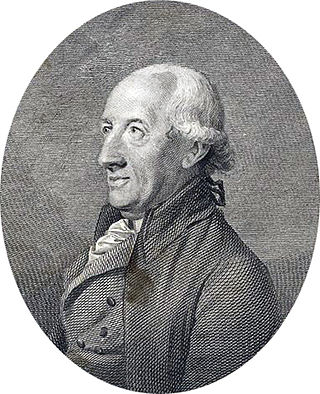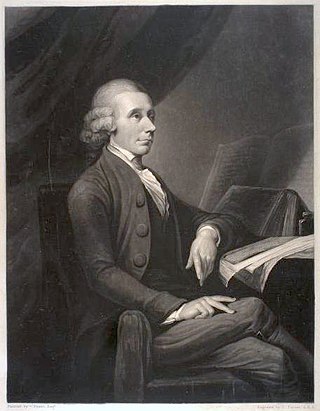Biography
He was born at Leeds, West Yorkshire on 25 February 1701: his father Henry Adam was a solicitor and town clerk of the Leeds Corporation, his mother Elizabeth, daughter of Jasper Blythman. They had six children, of whom Thomas was the third. [1] [2]
Adam received his first education at Leeds Grammar School, then under Thomas Barnard; later he was transferred to Queen Elizabeth Grammar School, Wakefield. [1] He matriculated at Christ's College, Cambridge in 1720, where he was for two years. He then moved to Hart Hall, Oxford, through the influence of Richard Newton. [2] He took the degree of B.A., but took no further degree on account of certain scruples in Newton's book on "Pluralities". In 1724 he was presented, through the interest of an uncle, to the living of Winteringham, in the Lincolnshire (now North Lincolnshire). He was then under age ecclesiastically, and it was held for a year for him. Here he remained for 58 years, never wishing to change. His income rarely exceeded £200 per annum. [1]
Adam died on 31 March 1784, in his 84th year. [1]
Laurence Tomson was an English politician, author, and translator. He acted as the personal secretary of Sir Francis Walsingham, the secretary of state to Elizabeth I of England.

John Berkenhout was an English physician, naturalist and miscellaneous writer. He was educated as a physician at Edinburgh and Leyden. While at Edinburgh he published a botanical lexicon Clavis Anglicae Linguae Botanicae. He published several works on natural history, including Outlines of the Natural History of Great Britain and Ireland (1769) and Synopsis of the Natural History of Great Britain and Ireland (1789). He served as a British agent in the colonies during the American Revolution.
John Barclay AM (1734–1798) was a Scottish minister of religion, and founder of the Bereans.
Joseph Milner (1744–1797), an English evangelical divine, has a reputation particularly for his work on The History of the Church of Christ (1794–1809).

Edward Wells (1667–1727) was an English mathematician, geographer, and controversial theologian.

The Theological Repository was a periodical founded and edited from 1769 to 1771 by the eighteenth-century British polymath Joseph Priestley. Although ostensibly committed to the open and rational inquiry of theological questions, the journal became a mouthpiece for Dissenting, particularly Unitarian and Arian, doctrines.
Arthur Jackson (1593?-1666) was an English clergyman of strong Presbyterian and royalist views. He was imprisoned in 1651 for suspected complicity in the ‘presbyterian plot’ of Christopher Love, and ejected after the Act of Uniformity 1662.

Sir Nathaniel Gould was an English merchant and politician who sat in the House of Commons of England from 1701 to 1707 and in the House of Commons of Great Britain between 1707 and 1728.
Thomas Bennet (1673–1728) was an English clergyman, known for controversial and polemical writings, and as a Hebraist.
Critici sacri was a compilation of Latin biblical commentaries published in London from 1660, edited by John Pearson. The publisher was Cornelius Bee. The work appeared in nine volumes, and collected numerous authors, both Protestant and Catholic, of early modern critical work on the Bible. It was intended to complement Brian Walton's Polyglot Bible, and set off a series of subsequent related publications.
The Socinian controversy in the Church of England was a theological argument on christology carried out by English theologians for around a decade from 1687. Positions that had remained largely dormant since the death in 1662 of John Biddle, an early Unitarian, were revived and discussed, in pamphlet literature.
Sir Richard Ellys (1688?–1742), of Nocton, Lincolnshire and Bolton Street, Piccadilly, Westminster, was an English Whig politician who sat in the English House of Commons and British House of Commons between 1701 and 1734. He was a bibliophile, and theological writer.
Peter Whalley (1722–1791) was an English clergyman, academic and schoolmaster. He is known as an antiquarian author and literary editor, and particularly as editor of John Bridges' county history of Northamptonshire.
John Francis was an English sculptor.

Robert Harding Evans (1778–1857) was an English bookseller and auctioneer.
Susanna Hopton née Harvey (1627–1709) was an English devotional writer.
Francis Lee was an English writer and physician, known for his connection with the Philadelphians.

Francis Bugg (1640–1727) was an English writer against Quakerism.
James Stillingfleet (1741–1826) was an English evangelical cleric, vicar of Hotham in Yorkshire from 1771 until his death.
This page is based on this
Wikipedia article Text is available under the
CC BY-SA 4.0 license; additional terms may apply.
Images, videos and audio are available under their respective licenses.
![]() This article incorporates text from a publication now in the public domain : Stephen, Leslie, ed. (1885). "Adam, Thomas". Dictionary of National Biography . Vol. 1. London: Smith, Elder & Co.
This article incorporates text from a publication now in the public domain : Stephen, Leslie, ed. (1885). "Adam, Thomas". Dictionary of National Biography . Vol. 1. London: Smith, Elder & Co.




